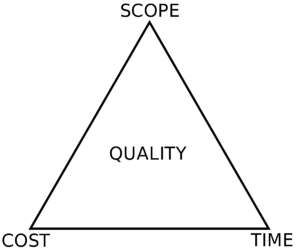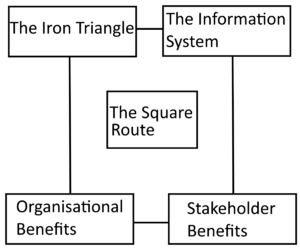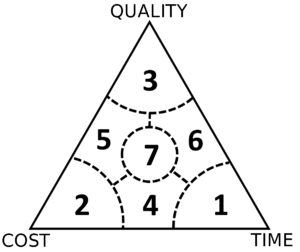The iron triangle as an analytical tool
(→Application of the Iron Triangle) |
|||
| Line 63: | Line 63: | ||
=== Constraint Management === | === Constraint Management === | ||
| − | As discussed previously, the relevancy of the most relevant success criteria can vary significantly across different kinds of projects. Nonetheless, a project manager should still be able to implement and understand the best practices when applying the Iron Triangle. However, while the PMBOK® Guide does not have any direct reference of when or how the tool should be applied, a connection can be made between the application of the constraints and two critical points that appear throughout all of these from the PMBOK® Guide's process flow; planning and controlling. The general assessments having to be conducted shared for various constraints have been listed below: | + | As discussed previously, the relevancy of the most relevant success criteria can vary significantly across different kinds of projects. Nonetheless, a project manager should still be able to implement and understand the best practices when applying the Iron Triangle. However, while the PMBOK® Guide<ref name="PMBOK" /> does not have any direct reference of when or how the tool should be applied, a connection can be made between the application of the constraints and two critical points that appear throughout all of these from the PMBOK® Guide's<ref name="PMBOK" /> process flow; planning and controlling. The general assessments having to be conducted shared for various constraints have been listed below: |
''' Planning: ''' | ''' Planning: ''' | ||
| Line 128: | Line 128: | ||
Test. <ref name="ERROR"> Atkinson RW. Effective Organisations, Re-framing the Thinking for Information Systems Projects Success, pp. 13-16. Cassell, London, 1997.</ref> | Test. <ref name="ERROR"> Atkinson RW. Effective Organisations, Re-framing the Thinking for Information Systems Projects Success, pp. 13-16. Cassell, London, 1997.</ref> | ||
| + | |||
| + | Test. <ref name="SIX"> Siegelaub, J. M. (2007). Six (yes six!) constraints: an enhanced model for project control. Paper presented at PMI® Global Congress 2007—North America, Atlanta, GA. Newtown Square, PA: Project Management Institute.</ref> | ||
Test. <ref name="PMBOK" /> | Test. <ref name="PMBOK" /> | ||
Revision as of 00:34, 22 February 2021
Contents |
Abstract
NB: Quick disclaimer for Peer Review reader. This Wiki in its current state depicts the main findings I want to present in the final hand-in. However, I did not have the time for this peer review to polish the article as intented for the final hand-in. I hope that you'll be able to look past potential substandard mistakes and the currently lacking 'Application' part, and instead give feedback on the overall context included in the article, the focus of the article, the interplay between the different parts, and the (potential lack of) "red threat". Thank you!
This article aims to present the Iron Triangle (also known as Project Management Triangle, Project Triangle, and Triple Constraint Triangle) as an analytical tool with a focus on Project Management through the perspective of Purpose. The Iron Triangle is considered as one of the most fundamental project management models regarding success and is based on the interrelationships between key project performance metrics, which in this case are defined as constraints. With its origins from the 1950’s, the Iron Triangle was originally applied to settle on initial project estimates and thereby evaluating the project success regarding if these estimates were met. However, this article is going to present some of the most concurrent criticisms and limitations of the classic Iron Triangle, and how key research spanning many years and crossing various industries have let to the mitigations of these issues. This has let the enhancement of the approach of the Iron Triangle into an analytical tool with the purpose of not only defining project frameworks but also to continuously assess project performance throughout its lifespan by guiding project managers to where adjustments in project constraints must be made in when changes in other constraints occur.
With regards to the application of the tool, it is first presented how each constraint application take place in at least two points of PMI’s Project Management Body of Knowledge’s processes; planning and controlling, and how PRINCE2 handles these applications. Then, practical, and strategic approaches to the balancing of the triple constraints will be presented through the Iron Triangle’s core concept of project tradeoffs. Lastly, it will be discussed how project managers can leverage the Iron Triangle from representing a set of pre-defined specifications (classic view of projects) to an analytical tool focusing on value creation (state of the art view of projects) based on relevant success criteria. Here the methodology of conformance (value protection) vs. performance (value creation) will also be included.
The Iron Triangle and its most common variations
The Iron Triangle (also known as Project Management Triangle, Project Triangle, and Triple Constraint Triangle) is an essential tool that aims to present the concept of which project success should be understood. The Iron Triangle was proposed by Martin Barnes back in 1969 [1] [2] and has since then undertaken various different takes on changes, additions, and updates. Throughout time, the Iron Triangle has always been represented by the key project performance metrics that any project success is measured by, defined as constraints; namely Time and Cost [3] [1]. However, as extensively and thoroughly analysed by the rather up-to-date What is the Iron Triangle, and how has it changed? (2018) [3], it is presented that depending on the given project specifications and other varying debatable factors, either Quality, Scope, Performance, or Requirements are most often applied interchangeably as the triangle's third constraint. So, in other words, the Iron Triangle aims to represent the constraints of whether a project is delivered on time, within its budget, and to an agreed extension of quality, scope, performance, or requirement. Hereby, the main focus of the tool is defined to be Project Management, as some of the most cited project management standards have somewhat aligned views of project success in comparison to the core principals of the Iron Triangle. For example, the Guide to the Project Management Body of Knowledge [4] presents a comparative overview of the success definition in Project, Program, and Portfolio Management as seen in the table below.
| Projects | Programs | Portfolios | |
|---|---|---|---|
| Success | Success is measured by product and project quality, timeliness, budget compliance, and degree of customer satisfaction. |
A program’s success is measured by the program’s ability to deliver its intended benefits to an organization, and by the program’s efficiency and effectiveness in delivering those benefits. |
Success is measured in terms of the aggregate investment performance and benefit realization of the portfolio. |
The Iron Triangle is most effective in displaying and communicating interdependencies between the above-presented success criteria. As seen in Figure 1 below, the classic depiction of the tool is a triangle with each constraint located at each corner of the triangle. The primary nature of the triangle’s constraint behaviour is formulated famously as “good, fast or cheap - pick two” [5], describing how the adjustment of focus in a specific constraint warrant compensating changes in one or both of the other constraints. With the Iron Triangle covering such core fundamentals of project management, it has been found that the neglection of its criteria can have devastating consequences on the success of a project in spite of efficient and effective management of other project metrics [4]. One of the newer and most popular depictions of the tool can be seen in Figure 2, where Quality is now defined as its own new dimension as the outcome of the Iron Triangle, while Scope has replaced its place as a constraint. The movement of accepting and replacing the Quality criteria truly took off with “Cost, time and quality, two best guesses and a phenomenon, it’s time to accept other success criteria” [6], where the Iron Triangle method primarily was criticized for its heavy reliance of often unrealistic parameter estimation and un-flexible conditions of evaluating success by initial estimates. However, this is not the only documented limitation of the Iron Triangle which leads us to the next part of this article, the limitations of the Iron Triangle.
Limitations Caused by Simplicity and possible mitigations of these
With such an old and fundamental tool as the Iron Triangle, it is of no surprise that research has pointed out some of the tool's most obvious limitations. Instead of saving the limitations of the Iron Triangle to the very end of this article, I'm instead going to address them here before the application process. The reason for this being, that this article thereby has the possibility of presenting not only the limitations but also well-known mitigations of these when discussing the application of the tool. One of the overarching criticisms of the Iron Triangle is its over-simplification of measuring project success. This had led to two well-known limitations that be applicable for many projects; the Iron Triangle uses the wrong measurements when measuring project success, the Iron Triangle measures wrongly when measuring project success. These two limitations can each be classified within the IS-IT projects thinking errors [7] [6]; Type I Errors being when something is done wrong, and Type II Errors being when something is not done as adequately as it could have been. Below, the two most well-known frameworks of counteracting these limitations is presented.
Type I Errors
Research has increasingly started to suggest that although the Iron Triangle is important, it does not tell the whole story of project success. For example, Pinto and Pinto (1991) distinguished between short-term and long-term success criteria, categorizing the Iron Triangle as a short-term set of criteria, compared to criteria such as project benefits. Badewi (2016) argued that a strong focus on the Iron Triangle creates an overly output-focused mentality. Too much focus on the Iron Triangle can limit organisational effectiveness in realising benefits, and in the distribution between project managers and functional managers authority and responsibility (Maylor et al, 2006). In addition, Turner and Zolin (2012, p. 12) note that “…evaluations of project success by stakeholders are inherently subjective and cannot be summarized naively into the iron triangle without under or overestimating project success at critical points in the project life cycle.” This points directly do the point of actually assessing which project constraints are relevant depending on the type of project as seen in Figure 3.
In the construction industry, Collins and Baccarini (2004) note that project success must go beyond meeting Time, Cost and Quality objectives. Toor and Ogunlana (2010) also identify that other performance indicators such as safety, efficient use of resources, effectiveness, stakeholder satisfaction, and conflict and dispute reduction are increasingly important in construction. Literature on project management education in this period further supports the call to extend the focus of project management beyond the Iron Triangle. By comprimising on one of the tools main features, its simplicity, the PMBOK® Guide uses a popular alternative model to the triple constraint. It lists six constraints, made from two overlapping triangles in a star shape as seen in Figure 4. As you can see, the project management star also distinguishes between scope and quality. Here, it says scope is constrained by the budget and schedule, while quality is assured by managing risks and resources.
Type II Errors
In 1999, Atkinson, in the single most cited paper in either the Project Management Journal or the International Journal of Project Management (search on Scopus 21/8/17), critiqued the weight given to the Iron Triangle as the primary measure of project success. He asserted that Time and Cost are ‘only guesses’ and that Quality is a ‘phenomenon’, suggesting that new criteria are needed to evaluate the success of projects. Gardiner and Stewart (2000) extend on this, estimating that 50–70% of projects have significant budget or schedule overruns, concluding that initial estimates are inadequate for evaluating success, especially if they are used to benchmark management processes. Here, a new model extended the way success was measured called the Square Route model, which can be seen in Figure 5. Here, the Iron Triangle no longer stands by itself but is surrounded by three other criteria of success; the information system, the benefits to the organization, and the benefits to the stakeholder community.
Application of the Iron Triangle
This part aims to present how project managers can apply the Iron Triangle to their projects with its presented limitations in mind.
Constraint Management
As discussed previously, the relevancy of the most relevant success criteria can vary significantly across different kinds of projects. Nonetheless, a project manager should still be able to implement and understand the best practices when applying the Iron Triangle. However, while the PMBOK® Guide[4] does not have any direct reference of when or how the tool should be applied, a connection can be made between the application of the constraints and two critical points that appear throughout all of these from the PMBOK® Guide's[4] process flow; planning and controlling. The general assessments having to be conducted shared for various constraints have been listed below:
Planning:
- what the constraints/ tolerances should be (if they have not been previously defined),
- who should be setting them (and when),
- how they are to be used by the project manager,
- how the sponsor/ stakeholders/ Project Board will be kept informed of the status of the constraints and project.
Controlling
- determining what is going on in the project (standard data collection/ monitoring processes),
- assessing how that compares against the constraints/ tolerances the sponsor/ stakeholders/ Project Board have agreed to with the project manager,
- whether any of the constraints/ tolerances been breeched – or threaten to be breached,
- proposing and recommending alternatives for addressing the breech.
Constraint Balancing
As discussed above, it should be clear that the project manager should clearly define the critical success criteria that work the best for them. In this application part, we are going to work with the classical Time, Cost, and Quality as [3] concluded that while the third criterion of Quality could be replaced by other depending on the definition of the project in question, that the Iron Triangle is defined by its classic triple constraint as it based on their analysis was found that these three concepts are highly interconnected, more so than any other combination of project management concepts. So, while still acknowledging that Time, Cost, and Quality is not defined as "fit for all" projects, this application process making use of exactly these for the sake of generalization and common ground.
One should not blindly assume that Quality is the most fitting constraints to their specific project. Take NASA for example; they...
- Immovable deadline - do what is necessary to hit it
- Cost is everything - time and quality must give
- Requirements must be met, however, slowly or expensively
- Time and cost immovable, quality must give
- Quality must be delivered within budget, but no hurry
- Deadline is fixed, quality must be met, the sponsor is prepared to pay
- An evenly-balanced situation - everything is negotiable to deliver success
Avoid Tunnel Vision
To not apply the Iron Triangle as its own stand alone tool. Must not neglect Business Case, Vision, Long-Term benefits, and priorities (what are the ACTUAL success criteria of this very project?)
Annotated bibliography
Key references:
A guide to the Project Management Body of Knowledge (PMBOK guide), 6th Edition (2017)
Managing Successful Projects with PRINCE2, 6th Edition (2017)
Test [3]
Test [8]
Test. [4]
Test. [1]
Test. [6]
Test. [9]
Test. [10]
Test. [2]
Test. [5]
Test. [11]
Test. [7]
Test. [12]
Test. [4]
Bibliography
- ↑ 1.0 1.1 1.2 Wright, Andrew, and Therese Lawlor-Wright. “Project Success and Quality: Balancing the Iron Triangle.” Project Success and Quality: Balancing the Iron Triangle, Taylor and Francis, 2018, pp. 171–177. doi:10.4324/9781351213271.
- ↑ 2.0 2.1 Vahidi, Ramesh & Greenwood, David. (2009). TRIANGLES, TRADEOFFS AND SUCCESS: A CRITICAL EXAMINATION OF SOME TRADITIONAL PROJECT MANAGEMENT PARADIGMS. 10.13140/2.1.2809.1520.
- ↑ 3.0 3.1 3.2 3.3 Pollack, J., Helm, J. and Adler, D. (2018), "What is the Iron Triangle, and how has it changed?", International Journal of Managing Projects in Business, Vol. 11 No. 2, pp. 527-547.
- ↑ 4.0 4.1 4.2 4.3 4.4 4.5 4.6 4.7 Project Management Institute, Inc. (2017). Guide to the Project Management Body of Knowledge (PMBOK® Guide) (6th Edition) - 2. Initiating Process Group. Project Management Institute, Inc. (PMI). pp. XXX. Retrieved from https://app.knovel.com/hotlink/pdf/id:kt011DXQ4C/guide-project-management/initiating-process-group
- ↑ 5.0 5.1 Van Wyngaard, C. & Pretorius, Jan-Harm & Pretorius, Leon. (2012). Theory of the triple constraint — A conceptual review. 1991-1997. pp. 1192-1195 10.1109/IEEM.2012.6838095.
- ↑ 6.0 6.1 6.2 6.3 Roger Atkinson, Project management: cost, time and quality, two best guesses and a phenomenon, its time to accept other success criteria, International Journal of Project Management, Volume 17, Issue 6, 1999, Pages 337-342.
- ↑ 7.0 7.1 Atkinson RW. Effective Organisations, Re-framing the Thinking for Information Systems Projects Success, pp. 13-16. Cassell, London, 1997.
- ↑ AXELOS. Managing Successful Projects with PRINCE2 2017 Edition, The Stationery Office Ltd, 2017. pp. XXX. ProQuest Ebook Central, https://ebookcentral-proquest-com.proxy.findit.dtu.dk/lib/DTUDK/detail.action?docID=4863041.
- ↑ Gabriella Cserháti, Lajos Szabó, The relationship between success criteria and success factors in organisational event projects, International Journal of Project Management, Volume 32, Issue 4, 2014, Pages 613-624. ISSN 0263-7863.
- ↑ Test. Pinto, J., Project Management: Achieving Competitive Advantage. New Jersey: Pearson Education, 2010, pp. 35-40.
- ↑ T. S. Mokoena, J. H. C. Pretorius and C. J. Van Wyngaard, "Triple constraint considerations in the management of construction projects," 2013 IEEE International Conference on Industrial Engineering and Engineering Management, Bangkok, Thailand, 2013, pp. 813-817, doi: 10.1109/IEEM.2013.6962524.
- ↑ Siegelaub, J. M. (2007). Six (yes six!) constraints: an enhanced model for project control. Paper presented at PMI® Global Congress 2007—North America, Atlanta, GA. Newtown Square, PA: Project Management Institute.





